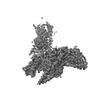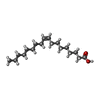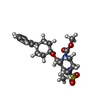+ データを開く
データを開く
- 基本情報
基本情報
| 登録情報 |  | |||||||||
|---|---|---|---|---|---|---|---|---|---|---|
| タイトル | Structure of the orexin-2 receptor(OX2R) bound to TAK-925, Gi and scFv16 | |||||||||
 マップデータ マップデータ | Orexin-2 receptor (OX2R) bound to TAK-925, Gi and scFv16 | |||||||||
 試料 試料 |
| |||||||||
| 機能・相同性 |  機能・相同性情報 機能・相同性情報regulation of circadian sleep/wake cycle, wakefulness / circadian sleep/wake cycle process / orexin receptor activity / Orexin and neuropeptides FF and QRFP bind to their respective receptors / neuropeptide receptor activity / Olfactory Signaling Pathway / Sensory perception of sweet, bitter, and umami (glutamate) taste / Synthesis, secretion, and inactivation of Glucagon-like Peptide-1 (GLP-1) / Activation of the phototransduction cascade / feeding behavior ...regulation of circadian sleep/wake cycle, wakefulness / circadian sleep/wake cycle process / orexin receptor activity / Orexin and neuropeptides FF and QRFP bind to their respective receptors / neuropeptide receptor activity / Olfactory Signaling Pathway / Sensory perception of sweet, bitter, and umami (glutamate) taste / Synthesis, secretion, and inactivation of Glucagon-like Peptide-1 (GLP-1) / Activation of the phototransduction cascade / feeding behavior / locomotion / Activation of G protein gated Potassium channels / G-protein activation / G beta:gamma signalling through PI3Kgamma / Prostacyclin signalling through prostacyclin receptor / G beta:gamma signalling through PLC beta / ADP signalling through P2Y purinoceptor 1 / Thromboxane signalling through TP receptor / Presynaptic function of Kainate receptors / G beta:gamma signalling through CDC42 / Inhibition of voltage gated Ca2+ channels via Gbeta/gamma subunits / Glucagon-type ligand receptors / Adrenaline,noradrenaline inhibits insulin secretion / G alpha (12/13) signalling events / G beta:gamma signalling through BTK / ADP signalling through P2Y purinoceptor 12 / Cooperation of PDCL (PhLP1) and TRiC/CCT in G-protein beta folding / Thrombin signalling through proteinase activated receptors (PARs) / Ca2+ pathway / G alpha (z) signalling events / Extra-nuclear estrogen signaling / G alpha (s) signalling events / G alpha (q) signalling events / G alpha (i) signalling events / Glucagon-like Peptide-1 (GLP1) regulates insulin secretion / Vasopressin regulates renal water homeostasis via Aquaporins / peptide hormone binding / Adenylate cyclase inhibitory pathway / neuropeptide signaling pathway / positive regulation of protein localization to cell cortex / regulation of cAMP-mediated signaling / D2 dopamine receptor binding / G protein-coupled serotonin receptor binding / regulation of mitotic spindle organization / cellular response to forskolin / cellular response to hormone stimulus / regulation of cytosolic calcium ion concentration / adenylate cyclase-inhibiting G protein-coupled receptor signaling pathway / Regulation of insulin secretion / G protein-coupled receptor binding / peptide binding / G-protein beta/gamma-subunit complex binding / adenylate cyclase-modulating G protein-coupled receptor signaling pathway / ADP signalling through P2Y purinoceptor 12 / response to peptide hormone / photoreceptor disc membrane / Adrenaline,noradrenaline inhibits insulin secretion / G alpha (z) signalling events / cellular response to catecholamine stimulus / ADORA2B mediated anti-inflammatory cytokines production / adenylate cyclase-activating dopamine receptor signaling pathway / cellular response to prostaglandin E stimulus / GPER1 signaling / GDP binding / G-protein beta-subunit binding / heterotrimeric G-protein complex / signaling receptor complex adaptor activity / phospholipase C-activating G protein-coupled receptor signaling pathway / cell cortex / midbody / G alpha (i) signalling events / G alpha (s) signalling events / G alpha (q) signalling events / chemical synaptic transmission / Extra-nuclear estrogen signaling / G protein-coupled receptor signaling pathway / cell cycle / cell division / lysosomal membrane / GTPase activity / centrosome / synapse / nucleolus / GTP binding / magnesium ion binding / extracellular exosome / nucleoplasm / membrane / plasma membrane / cytoplasm 類似検索 - 分子機能 | |||||||||
| 生物種 |  Homo sapiens (ヒト) / Homo sapiens (ヒト) /  | |||||||||
| 手法 | 単粒子再構成法 / クライオ電子顕微鏡法 / 解像度: 3.17 Å | |||||||||
 データ登録者 データ登録者 | McGrath AP / Kang Y / Flinspach M | |||||||||
| 資金援助 | 1件
| |||||||||
 引用 引用 |  ジャーナル: Nat Commun / 年: 2022 ジャーナル: Nat Commun / 年: 2022タイトル: Molecular mechanism of the wake-promoting agent TAK-925. 著者: Jie Yin / Yanyong Kang / Aaron P McGrath / Karen Chapman / Megan Sjodt / Eiji Kimura / Atsutoshi Okabe / Tatsuki Koike / Yuhei Miyanohana / Yuji Shimizu / Rameshu Rallabandi / Peng Lian / ...著者: Jie Yin / Yanyong Kang / Aaron P McGrath / Karen Chapman / Megan Sjodt / Eiji Kimura / Atsutoshi Okabe / Tatsuki Koike / Yuhei Miyanohana / Yuji Shimizu / Rameshu Rallabandi / Peng Lian / Xiaochen Bai / Mack Flinspach / Jef K De Brabander / Daniel M Rosenbaum /    要旨: The OX orexin receptor (OXR) is a highly expressed G protein-coupled receptor (GPCR) in the brain that regulates wakefulness and circadian rhythms in humans. Antagonism of OXR is a proven therapeutic ...The OX orexin receptor (OXR) is a highly expressed G protein-coupled receptor (GPCR) in the brain that regulates wakefulness and circadian rhythms in humans. Antagonism of OXR is a proven therapeutic strategy for insomnia drugs, and agonism of OXR is a potentially powerful approach for narcolepsy type 1, which is characterized by the death of orexinergic neurons. Until recently, agonism of OXR had been considered 'undruggable.' We harness cryo-electron microscopy of OXR-G protein complexes to determine how the first clinically tested OXR agonist TAK-925 can activate OXR in a highly selective manner. Two structures of TAK-925-bound OXR with either a G mimetic or G reveal that TAK-925 binds at the same site occupied by antagonists, yet interacts with the transmembrane helices to trigger activating microswitches. Our structural and mutagenesis data show that TAK-925's selectivity is mediated by subtle differences between OX and OX receptor subtypes at the orthosteric pocket. Finally, differences in the polarity of interactions at the G protein binding interfaces help to rationalize OXR's coupling selectivity for G signaling. The mechanisms of TAK-925's binding, activation, and selectivity presented herein will aid in understanding the efficacy of small molecule OXR agonists for narcolepsy and other circadian disorders. | |||||||||
| 履歴 |
|
- 構造の表示
構造の表示
| 添付画像 |
|---|
- ダウンロードとリンク
ダウンロードとリンク
-EMDBアーカイブ
| マップデータ |  emd_25389.map.gz emd_25389.map.gz | 49.7 MB |  EMDBマップデータ形式 EMDBマップデータ形式 | |
|---|---|---|---|---|
| ヘッダ (付随情報) |  emd-25389-v30.xml emd-25389-v30.xml emd-25389.xml emd-25389.xml | 20.3 KB 20.3 KB | 表示 表示 |  EMDBヘッダ EMDBヘッダ |
| FSC (解像度算出) |  emd_25389_fsc.xml emd_25389_fsc.xml | 11.7 KB | 表示 |  FSCデータファイル FSCデータファイル |
| 画像 |  emd_25389.png emd_25389.png | 51.4 KB | ||
| アーカイブディレクトリ |  http://ftp.pdbj.org/pub/emdb/structures/EMD-25389 http://ftp.pdbj.org/pub/emdb/structures/EMD-25389 ftp://ftp.pdbj.org/pub/emdb/structures/EMD-25389 ftp://ftp.pdbj.org/pub/emdb/structures/EMD-25389 | HTTPS FTP |
-検証レポート
| 文書・要旨 |  emd_25389_validation.pdf.gz emd_25389_validation.pdf.gz | 441.6 KB | 表示 |  EMDB検証レポート EMDB検証レポート |
|---|---|---|---|---|
| 文書・詳細版 |  emd_25389_full_validation.pdf.gz emd_25389_full_validation.pdf.gz | 441.2 KB | 表示 | |
| XML形式データ |  emd_25389_validation.xml.gz emd_25389_validation.xml.gz | 10.9 KB | 表示 | |
| CIF形式データ |  emd_25389_validation.cif.gz emd_25389_validation.cif.gz | 14.2 KB | 表示 | |
| アーカイブディレクトリ |  https://ftp.pdbj.org/pub/emdb/validation_reports/EMD-25389 https://ftp.pdbj.org/pub/emdb/validation_reports/EMD-25389 ftp://ftp.pdbj.org/pub/emdb/validation_reports/EMD-25389 ftp://ftp.pdbj.org/pub/emdb/validation_reports/EMD-25389 | HTTPS FTP |
-関連構造データ
| 関連構造データ |  7sqoMC  7sr8C M: このマップから作成された原子モデル C: 同じ文献を引用 ( |
|---|---|
| 類似構造データ | 類似検索 - 機能・相同性  F&H 検索 F&H 検索 |
- リンク
リンク
| EMDBのページ |  EMDB (EBI/PDBe) / EMDB (EBI/PDBe) /  EMDataResource EMDataResource |
|---|---|
| 「今月の分子」の関連する項目 |
- マップ
マップ
| ファイル |  ダウンロード / ファイル: emd_25389.map.gz / 形式: CCP4 / 大きさ: 52.7 MB / タイプ: IMAGE STORED AS FLOATING POINT NUMBER (4 BYTES) ダウンロード / ファイル: emd_25389.map.gz / 形式: CCP4 / 大きさ: 52.7 MB / タイプ: IMAGE STORED AS FLOATING POINT NUMBER (4 BYTES) | ||||||||||||||||||||
|---|---|---|---|---|---|---|---|---|---|---|---|---|---|---|---|---|---|---|---|---|---|
| 注釈 | Orexin-2 receptor (OX2R) bound to TAK-925, Gi and scFv16 | ||||||||||||||||||||
| ボクセルのサイズ | X=Y=Z: 1.04 Å | ||||||||||||||||||||
| 密度 |
| ||||||||||||||||||||
| 対称性 | 空間群: 1 | ||||||||||||||||||||
| 詳細 | EMDB XML:
|
-添付データ
- 試料の構成要素
試料の構成要素
+全体 : Human OX2R in complex with Gai/Gb/Gg-scFv16.
+超分子 #1: Human OX2R in complex with Gai/Gb/Gg-scFv16.
+超分子 #2: Orexin receptor type 2
+超分子 #3: Guanine nucleotide-binding protein G(i) subunit alpha-1
+超分子 #4: Guanine nucleotide-binding protein G(I)/G(S)/G(T) subunit beta-1,...
+超分子 #5: scFv-16
+分子 #1: Orexin receptor type 2
+分子 #2: Guanine nucleotide-binding protein G(i) subunit alpha-1
+分子 #3: Guanine nucleotide-binding protein G(I)/G(S)/G(T) subunit beta-1
+分子 #4: Guanine nucleotide-binding protein G(I)/G(S)/G(O) subunit gamma-2
+分子 #5: scFv-16
+分子 #6: OLEIC ACID
+分子 #7: methyl (2R,3S)-3-[(methanesulfonyl)amino]-2-({[(1s,4S)-4-phenylcy...
-実験情報
-構造解析
| 手法 | クライオ電子顕微鏡法 |
|---|---|
 解析 解析 | 単粒子再構成法 |
| 試料の集合状態 | particle |
- 試料調製
試料調製
| 濃度 | 5 mg/mL |
|---|---|
| 緩衝液 | pH: 7.2 |
| 凍結 | 凍結剤: ETHANE |
- 電子顕微鏡法
電子顕微鏡法
| 顕微鏡 | FEI TITAN KRIOS |
|---|---|
| 特殊光学系 | エネルギーフィルター - 名称: GIF Bioquantum |
| 撮影 | フィルム・検出器のモデル: GATAN K2 SUMMIT (4k x 4k) 平均電子線量: 43.7 e/Å2 詳細: Cryo-EM movie stacks were collected on a Titan Krios microscope operated at 300 kV under EFTEM mode. Nanoprobe with 1um illumination area was used. Data were recorded on a postGIF Gatan K2 ...詳細: Cryo-EM movie stacks were collected on a Titan Krios microscope operated at 300 kV under EFTEM mode. Nanoprobe with 1um illumination area was used. Data were recorded on a postGIF Gatan K2 summit camera at a nominal magnification of 130,000, using super-resolution counting model. Bioquantum energy filter was operated in the zero-energy-loss mode with an energy slit width of 20 eV. |
| 電子線 | 加速電圧: 300 kV / 電子線源:  FIELD EMISSION GUN FIELD EMISSION GUN |
| 電子光学系 | 照射モード: FLOOD BEAM / 撮影モード: BRIGHT FIELD / Cs: 2.7 mm / 倍率(公称値): 130000 |
| 実験機器 |  モデル: Titan Krios / 画像提供: FEI Company |
+ 画像解析
画像解析
-原子モデル構築 1
| 精密化 | プロトコル: RIGID BODY FIT |
|---|---|
| 得られたモデル |  PDB-7sqo: |
 ムービー
ムービー コントローラー
コントローラー
























 Spodoptera (蝶・蛾)
Spodoptera (蝶・蛾)



